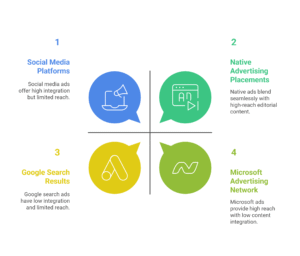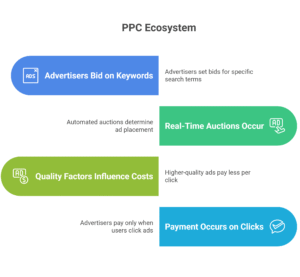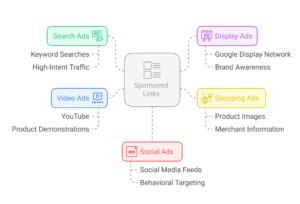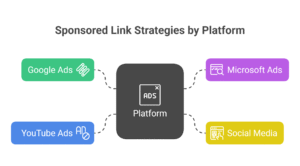If you’ve ever searched for something on Google, you’ve definitely encountered sponsored links. These strategically placed advertisements appear at the top of search results, often blending seamlessly with organic content. What many people don’t realize is that sponsored links represent one of the most powerful marketing tools available to businesses of all sizes.
Whether you’re a small business owner trying to compete with larger competitors or a marketing professional looking to master digital advertising, this comprehensive guide will equip you with the knowledge and strategies needed to create successful sponsored link campaigns that deliver real results.
What Are Sponsored Links?
Sponsored links are paid advertisements that appear on search engine results pages (SERPs), websites, or social media platforms when users search for related keywords or browse relevant content. Unlike traditional advertising where you pay upfront regardless of results, sponsored links operate on a performance-based model where you typically pay only when someone takes a specific action, such as clicking your ad.
Think of sponsored links as highly intelligent billboards that only appear to people who have demonstrated interest in what you’re offering. Instead of broadcasting your message to everyone, you’re targeting individuals who are actively searching for solutions you provide.
The precision of sponsored links sets them apart from traditional advertising methods. You can target users based on their search queries, geographic location, device type, time of day, and even their previous interactions with your website.
Where You’ll See Them

Sponsored links appear across multiple digital touchpoints, each serving different purposes in the customer journey:
- Google Search Results: These appear at the top and bottom of search results with a small “Ad” label. Google’s 2024 advertising updates show that text ads now include more extensions and dynamic features to improve user experience
- YouTube Video Advertising: Pre-roll, mid-roll, and display ads that appear before, during, or alongside video content
- Microsoft Advertising Network: Covering Bing, Yahoo, and partner sites, reaching over 1.4 billion users globally
- Native Advertising Placements: Sponsored content that blends with editorial content on news sites and blogs
- Social Media Platforms: Promoted posts and ads on Facebook, Instagram, LinkedIn, Twitter, and TikTok
The key to effective sponsored links is maintaining relevance and value. The most successful ads don’t feel like interruptions but rather helpful suggestions that address the user’s immediate needs.
Sponsored Links vs Organic Links
Understanding the distinction between sponsored and organic links is crucial for developing a comprehensive digital marketing strategy. Both serve important but different roles in your overall marketing ecosystem.
Key Differences
The fundamental differences between these approaches affect everything from costs to timeline to user perception:
- Sponsored Links: Offer immediate visibility through paid placement. You can launch a campaign and start receiving traffic within hours. Cost varies based on competition and targeting, but results are instant and scalable
- Organic Links: Earned through search engine optimization (SEO) efforts. Takes time to build authority and rankings, but provides sustainable, “free” traffic once established
Performance Comparison: Ahrefs’ 2024 study of 100,000 Google Ads campaigns found that paid ads receive 2.8x more clicks than organic results for commercial intent keywords, while organic results generate 8.5x more clicks for informational queries.
User trust also differs between formats. While some users skip sponsored results, others appreciate the immediate relevance and currency of paid advertisements. The labeling requirements ensure transparency, but the quality of your offer ultimately determines user response.
When to Use Each
Strategic timing makes the difference between success and wasted resources. Here’s when each approach works best:
Use sponsored links for:
- Product launches requiring immediate market awareness
- Seasonal promotions with limited time windows
- Testing new markets or customer segments
- Competing for high-value keywords where organic ranking is difficult
- Supporting sales teams with qualified lead generation
Use organic SEO for:
- Building long-term brand authority and credibility
- Capturing informational search traffic
- Reducing long-term customer acquisition costs
- Creating sustainable competitive advantages
The most successful businesses integrate both approaches, using sponsored links for immediate results while building organic presence for sustainable growth.
How Sponsored Links Work
Pay-Per-Click (PPC) Explained
The pay-per-click model revolutionized advertising by shifting risk from advertisers to performance. Unlike traditional media where you pay for estimated impressions, PPC ensures you only pay for measurable engagement.
Here’s how the PPC ecosystem functions:

- Advertisers bid on keywords: You specify the maximum amount you’re willing to pay for a click from someone searching specific terms
- Auctions occur in real-time: Every time someone searches, an automated auction determines which ads appear and in what order
- Quality factors influence costs: Higher-quality ads pay less per click and achieve better positions
- Payment occurs only on clicks: Impressions (views) are typically free; you pay only when someone clicks through to your website
This model creates natural efficiency incentives. Platforms want to show ads that users find valuable (leading to clicks), while advertisers want to attract genuinely interested prospects rather than casual browsers.
The Ad Auction & Ad Rank
The ad auction system ensures that the most relevant, highest-quality ads win placement, not just the highest bidders. This creates a more balanced ecosystem that benefits users, advertisers, and platforms.
The core formula is:
- Ad Rank = Bid Amount × Quality Score × Expected Impact of Extensions
- Quality Score = Expected Click-Through Rate + Ad Relevance + Landing Page Experience
This system means a smaller business with highly relevant ads can outrank larger competitors who rely solely on high bids. Google’s official documentation emphasizes that Quality Score improvements can reduce costs by up to 50% while improving ad positions.
Understanding this auction mechanism is crucial because it affects both your costs and your campaign performance. High-quality campaigns create a virtuous cycle: better relevance leads to higher Quality Scores, which result in lower costs and better positions, which generate more clicks and data for further optimization.
Types of Sponsored Links

Different sponsored link formats serve different marketing objectives and customer journey stages. Choosing the right format can dramatically impact your campaign performance and return on investment.
- Search Ads: Text-based advertisements triggered by specific keyword searches. These capture high-intent traffic from users actively seeking solutions.
- Display Ads: Visual advertisements appearing on websites within Google’s Display Network, reaching over 90% of global internet users. These excel at building brand awareness and retargeting previous website visitors
- Shopping Ads: Product-focused advertisements showing images, prices, and merchant information. Essential for e-commerce businesses, these ads generate 85% higher click-through rates than text ads for retail queries
- Video Ads: Engaging video content on YouTube and partner sites. With video consumption growing 100% year-over-year, these ads are crucial for storytelling and product demonstrations
- Social Ads: Native advertisements integrated into social media feeds. These leverage detailed demographic and behavioral targeting unavailable on search platforms
Format Performance Insight: HubSpot’s marketing research shows that campaigns using multiple ad formats achieve 23% higher conversion rates than single-format campaigns, emphasizing the importance of diversified advertising approaches.
The key is matching ad formats to user intent and campaign objectives. Search ads work best for immediate conversions, while display and video ads excel at building awareness and nurturing prospects through longer sales cycles.
How to Create a Successful Sponsored Link Campaign
Step 1: Keyword Targeting
Effective keyword targeting forms the foundation of successful sponsored link campaigns. The difference between profitable and wasteful advertising often comes down to keyword selection and organization.
Use tools like Google Keyword Planner, Ahrefs Keywords Explorer, or SEMrush Keyword Magic Tool to identify high-intent, achievable keywords. Focus on commercial intent indicators like “buy,” “best,” “review,” and “compare” rather than informational terms.
Advanced keyword strategies include:
- Long-tail keyword targeting: “Best CRM software for real estate agents” converts better than “CRM software” despite lower search volume
- Competitor keyword analysis: Identify gaps in competitor coverage using tools like SpyFu or iSpionage
- Seasonal keyword planning: Anticipate seasonal trends and adjust budgets accordingly
- Local keyword optimization: Include location modifiers for businesses serving specific geographic areas
Step 2: Write Irresistible Ad Copy
Compelling ad copy bridges the gap between user intent and your solution. With limited character counts and fierce competition for attention, every word must serve a purpose.
Essential ad copy elements:
- Headlines that match search intent: If someone searches “emergency plumber,” your headline should emphasize availability and speed, not experience or credentials
- Benefit-focused descriptions: “Save 10 hours per week” is more compelling than “advanced automation features”
- Clear, action-oriented CTAs: “Get Free Quote,” “Start Trial,” or “Book Consultation” work better than generic “Learn More”
- Social proof integration: “Trusted by 10,000+ businesses” or “5-star rated” builds credibility
- Urgency and scarcity: “Limited time offer” or “Only 3 spots left” can increase click-through rates
Step 3: Optimize Landing Pages
Landing page optimization can make or break your sponsored link campaigns. The best ad in the world won’t generate results if it leads to a poor landing experience.
Critical landing page elements:
- Message-match consistency: Your landing page headline should mirror your ad copy to reduce cognitive dissonance
- Fast loading speeds: Google’s Core Web Vitals research shows that pages loading in under 2 seconds achieve 15% higher conversion rates
- Mobile optimization: With 60% of searches occurring on mobile devices, mobile-first design is essential
- Single conversion focus: Each landing page should have one primary call-to-action to avoid decision paralysis
- Trust signals: Include testimonials, security badges, and contact information to build credibility
Use tools like Unbounce, Leadpages, or Instapage to create dedicated landing pages for different campaigns. Avoid sending paid traffic to your homepage, which typically has too many options and lacks specific focus.
Step 4: A/B Test Regularly
Continuous testing separates profitable campaigns from mediocre ones. Small improvements compound over time to create significant performance gains.
Testing methodology:
- Test one element at a time: Changing multiple variables simultaneously makes it impossible to identify what drove improvements
- Achieve statistical significance: Wait for enough data to make confident decisions, typically 100+ conversions per variation
- Test high-impact elements first: Headlines, primary images, and call-to-action buttons typically have the greatest impact on performance
- Document results: Keep records of winning variations to inform future campaigns
Step 5: Monitor Performance Metrics
Effective campaign management requires focusing on metrics that directly impact business objectives rather than vanity metrics that look impressive but don’t drive results.
Essential performance metrics:
- Click-Through Rate (CTR): Indicates ad relevance and quality. Industry benchmarks range from 2-5% depending on sector
- Conversion Rate: Shows landing page effectiveness. Track both macro-conversions (sales) and micro-conversions (email signups, downloads)
- Cost Per Acquisition (CPA): Your total cost to acquire one customer, including all campaign expenses
- Return on Ad Spend (ROAS): Revenue generated divided by advertising costs. A 4:1 ROAS means $4 in revenue for every $1 spent
- Quality Score: Google’s assessment of ad relevance, affecting both costs and positions
Use Google Analytics 4, Google Ads conversion tracking, and platform-specific analytics to monitor these metrics. Set up automated alerts for significant performance changes to enable quick responses to issues or opportunities.
Tips to Improve ROI with Sponsored Links
Maximizing return on investment requires advanced optimization techniques that go beyond basic campaign setup. These strategies can significantly improve profitability:
- Implement comprehensive negative keyword lists: Prevent your ads from showing for irrelevant searches. Add terms like “free,” “cheap,” or “DIY” if you sell premium products
- Use device and location bid adjustments: Increase bids for high-converting devices or locations, decrease for underperforming segments. Mobile traffic might convert at 50% the rate of desktop, warranting a bid reduction
- Optimize ad scheduling (dayparting): Schedule ads when your target audience is most active and likely to convert. B2B campaigns often perform better during business hours, while B2C campaigns might peak in evenings
- Leverage audience targeting: Layer demographic, interest, and behavioral audiences onto keyword targeting for increased precision
- Implement dynamic remarketing: Show personalized ads featuring products or services users previously viewed on your website
Advanced bidding strategies like Target CPA (Cost Per Acquisition) and Target ROAS (Return on Ad Spend) use machine learning to optimize bids automatically based on conversion likelihood, often outperforming manual bidding for established campaigns with sufficient historical data.
Sponsored Link Strategies by Platform

Google Ads
Google Ads dominates the search advertising landscape with over 90% market share. Success requires understanding Google’s unique features and optimization opportunities.
Google Ads best practices:
- Use responsive search ads: These automatically test different headline and description combinations, improving performance by up to 15%
- Enable Smart Bidding: Machine learning algorithms can optimize bids more effectively than manual adjustments for campaigns with 30+ conversions per month
- Implement audience segmentation: Create separate campaigns for different customer types (new vs. returning visitors, high-value vs. budget customers)
- Leverage ad extensions: Sitelinks, callouts, and structured snippets can increase CTR by up to 25%
Google’s Performance Max campaigns, introduced in 2021, use AI to automatically place ads across all Google properties (Search, YouTube, Display, etc.) based on your conversion goals and creative assets.
Microsoft Ads
Microsoft Advertising (formerly Bing Ads) offers unique advantages often overlooked by competitors focused solely on Google.
Microsoft Ads advantages:
- Lower competition: CPCs are typically 33-50% lower than Google Ads for similar keywords
- Affluent audience: Bing users have 22% higher household incomes on average
- Older demographics: 38% of Bing users are over 45, valuable for certain industries
- Easy campaign import: You can import Google Ads campaigns directly into Microsoft Ads
Social Media (Facebook, Instagram, LinkedIn)
Social media advertising excels at targeting based on demographics, interests, and behaviors rather than search intent.
Social media advertising strategies:
- Facebook/Instagram: Use lookalike audiences based on your best customers. Video content achieves 135% greater organic reach than photo posts
- LinkedIn: Target by job title, company size, and industry for B2B campaigns. LinkedIn ads cost more but generate higher-quality B2B leads
- TikTok: Focus on authentic, entertaining content that doesn’t feel like traditional advertising
The key to social media success is creating ads that feel native to each platform’s culture and user expectations. Formal corporate messaging works on LinkedIn but might fail on Instagram or TikTok.
YouTube Ads
Video advertising on YouTube offers unique storytelling opportunities and access to the world’s second-largest search engine.
YouTube advertising formats:
- Skippable in-stream ads: Play before videos, can be skipped after 5 seconds. Focus on hooking viewers immediately
- Non-skippable ads: 15-20 second ads that viewers must watch completely. Use for brand awareness or specific promotions
- Discovery ads: Appear in search results and suggested videos. These target users actively looking for related content
YouTube’s targeting options include keywords, topics, placements, and remarketing. You can show ads to people who searched for specific terms on Google or visited specific websites.
SEO Implications of Sponsored Links
The relationship between sponsored links and SEO is complex and often misunderstood. While paid advertising doesn’t directly influence organic rankings, strategic integration can amplify overall marketing performance.
- No direct ranking impact: Google’s official documentation confirms that paying for ads doesn’t improve organic search rankings
- Indirect SEO benefits: Sponsored links can drive traffic to high-quality content, potentially increasing engagement signals, social shares, and natural backlink acquisition
- Keyword intelligence: PPC campaigns provide immediate data about keyword performance, informing long-term SEO strategy
- Brand search volume: Successful advertising campaigns often increase branded search volume, which can positively impact overall organic visibility
The smartest approach combines both strategies: use sponsored links for immediate results and competitive keywords while building long-term organic authority through content marketing and SEO.
Disclosure & Legal Considerations
Follow FTC Guidelines
Proper disclosure isn’t just about legal compliance—it’s about building trust with your audience and maintaining the integrity of the advertising ecosystem.
- Clear labeling requirements: All sponsored content must be clearly labeled as “Ad,” “Sponsored,” or “Paid Partnership.” The disclosure must be prominent and easily noticeable
- Platform-specific rules: Each advertising platform has specific requirements for disclosure placement and formatting
- Influencer partnerships: When working with influencers or affiliates, ensure they properly disclose the business relationship
- Native advertising guidelines: Content that blends with editorial material requires especially clear disclosure to avoid misleading users
The FTC’s advertising guidelines emphasize that disclosures must be “clear and conspicuous,” meaning they should be easily noticed and understood by the average consumer.
Beyond legal requirements, transparent advertising builds trust. Users who feel deceived by unclear labeling are less likely to engage with your brand in the future.
Examples & Case Studies
Real-world success stories demonstrate how strategic sponsored link campaigns can transform business results across different industries and company sizes.
- E-commerce Success Story: A specialty outdoor gear retailer increased revenue by 340% year-over-year by switching from generic search ads to Google Shopping campaigns. By showcasing product images, prices, and reviews directly in search results, they achieved a 12% conversion rate compared to 3% from text ads
- B2B SaaS Optimization: A project management software company reduced customer acquisition costs by 60% by implementing account-based marketing through LinkedIn ads. By targeting specific job titles at companies with 50-500 employees, they achieved a 25% higher conversion rate while reducing overall ad spend
- Local Service Business: A dental practice in suburban Chicago increased new patient appointments by 180% using geo-targeted Facebook ads combined with Google Local Services ads. The integrated approach cost 40% less than traditional yellow pages advertising while delivering qualified leads
- Mobile App Growth: A fitness app startup acquired 50,000 users in 90 days using YouTube video ads and Instagram stories. The video content demonstrated app features in real-world scenarios, achieving a 8% install rate and 30-day retention rate of 45%
Common Mistakes to Avoid
Learning from common pitfalls can save thousands of dollars in wasted ad spend and prevent campaign failures that could have been easily avoided.
- Sending traffic to homepages: Your homepage serves multiple purposes and lacks focus. Create dedicated landing pages that match ad messaging and user intent. A campaign promoting “25% off running shoes” should lead to a running shoe category page with the discount prominently displayed
- Inadequate conversion tracking: Without proper tracking, you’re making decisions based on incomplete data. Implement Google Analytics 4, Facebook Pixel, and platform conversion tracking to understand the complete customer journey from click to purchase
- Overly broad keyword targeting: Broad keywords like “marketing” or “software” attract unqualified traffic and waste budget. Focus on specific, high-intent keywords like “email marketing automation for e-commerce” that indicate purchase readiness
- Ignoring mobile optimization: With mobile traffic representing 60% of searches, mobile-unfriendly landing pages kill conversions. Test your entire campaign funnel on mobile devices
- Set-and-forget mentality: Successful campaigns require ongoing optimization. Market conditions, competitor actions, and seasonal factors constantly affect performance
Another critical mistake is insufficient budget allocation for testing. Reserve 20% of your budget for testing new audiences, ad formats, and landing pages rather than putting everything into proven campaigns.
FAQs About Sponsored Links
Are sponsored links worth it?
When managed strategically, sponsored links deliver measurable ROI and provide scalable customer acquisition. Google’s Economic Impact Report shows that businesses earn an average of $8 for every $1 spent on Google Ads, though results vary significantly by industry, competition, and execution quality.
Success depends on several factors: proper keyword targeting, compelling ad copy, optimized landing pages, and sufficient budget for meaningful testing. Small businesses often see faster results than large enterprises because they can move quickly and target specific niches.
Do sponsored links help SEO?
Sponsored links don’t directly improve organic search rankings, but they can support SEO efforts indirectly. Paid campaigns can drive traffic to high-quality content, potentially increasing engagement metrics, social shares, and natural backlink acquisition that search engines consider for organic rankings.
Additionally, PPC campaigns provide valuable keyword performance data that can inform SEO content strategy. Keywords that convert well in paid campaigns often make excellent targets for organic content development.
Can small businesses compete with sponsored links?
Small businesses often have advantages in sponsored link advertising that larger competitors cannot match. They can target specific local markets, niche audiences, and long-tail keywords with less competition. Additionally, small businesses typically have higher customer service levels and more personalized experiences that can lead to better conversion rates.
The key is starting with focused, well-researched campaigns rather than trying to compete broadly against larger competitors with bigger budgets.
How much should I budget for sponsored links?
Budget allocation depends on industry, competition, and business goals. As a starting point, B2B companies typically allocate 5-15% of revenue to digital advertising, while B2C companies may spend 10-25%. Start with smaller budgets to test and prove ROI before scaling investment.
For new campaigns, budget enough for at least 100 clicks per ad group to gather meaningful performance data. This might require $500-2000 per month depending on your industry’s average cost-per-click.
Final Thoughts
Sponsored links represent one of the most powerful and measurable marketing channels available to modern businesses. Unlike traditional advertising where results are difficult to track and optimize, sponsored links provide immediate feedback and unlimited optimization opportunities.
The key to success lies in understanding that sponsored links are not just about bidding on keywords—they’re about creating valuable connections between your solutions and people actively seeking them. The most successful campaigns focus intensely on relevance, user experience, and continuous improvement based on real performance data.
Start with clear objectives, whether that’s increasing sales, generating leads, or building brand awareness. Choose the platforms and ad formats that best align with your goals and target audience. Most importantly, commit to ongoing testing and optimization rather than expecting immediate perfection.


